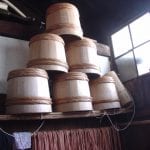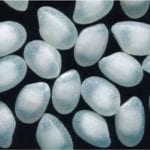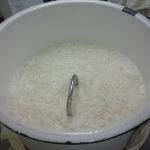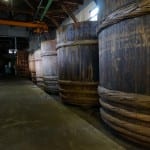This article was originally published in Sake Industry News Issue #17
 There are 47 prefectures in Japan, and every single one of them makes at least a little bit of sake. This was not the case until a few years ago, when one company in Kagoshima, the erstwhile lone holdout owing to its status as the premier sweet potato shochu producing region, added a sake to their array of shochu. Even in tropical Okinawa, the home of the idiosyncratic distillate awamori, there is one company who makes a tank or two of sake a year.
There are 47 prefectures in Japan, and every single one of them makes at least a little bit of sake. This was not the case until a few years ago, when one company in Kagoshima, the erstwhile lone holdout owing to its status as the premier sweet potato shochu producing region, added a sake to their array of shochu. Even in tropical Okinawa, the home of the idiosyncratic distillate awamori, there is one company who makes a tank or two of sake a year.
There are of course the major producing regions, like Hyogo, Kyoto, Niigata and Akita, and also those on the other end of the spectrum that produce very little. Buried in there somewhere amidst the more nondescript regions is Hokkaido. As the northernmost of Japan’s four main islands, Hokkaido is one prefecture all by its large self. But Hokkaido’s sake-brewing fortunes are possibly pivoting toward recognition and popularity.
The prefecture is attracting a lot of attention on several fronts that straddle a variety of industries. Namely, there are a couple of new breweries there on the sake production front; there are a handful of new sake rice varieties there showing up the agriculture front; and there is a lot of proactive tourism promotion there as well that continues to be a formidable destination draw. The intersecting aspects of these three are laden with potential as well.
Looking back a bit, Hokkaido once had over fifty breweries at its peak, and was the tenth largest brewing region. Things contracted from that zenith, and now there are only 13 breweries remaining, although many of them are noteworthy and appealing.
 Next, let us look at sake rice. I recall a brewer from one of the Hokkaido companies once telling me that he found an old brochure from his own company on the floor of the storage room in the brewery. In the brochure, the company boasted – not stated, mind you, but actually boasted – that all of their rice was from Japan’s main island, Honshu, and that none was from Hokkaido.
Next, let us look at sake rice. I recall a brewer from one of the Hokkaido companies once telling me that he found an old brochure from his own company on the floor of the storage room in the brewery. In the brochure, the company boasted – not stated, mind you, but actually boasted – that all of their rice was from Japan’s main island, Honshu, and that none was from Hokkaido.
Why? Because back then, Hokkaido rice had a pretty bad reputation. But a combination of agriculture technology and, unfortunate though it may be, climate change has made Hokkaido rice quite appealing, tasty and reasonably priced.
On top of regular table rice, much effort has been put into developing sake rice strains too, with good success. Hokkaido represents about 22 percent of Japan’s topography, so there is plenty of room for sake rice cultivation. And rising to that challenge, Hokkaido is now the second largest rice-producing prefecture (for all rice, of course, not just sake rice).
There are three main sake rice varieties developed and grown in Hokkaido, all created in the last twenty years or so. The most widely grown, Ginpu, tends to yield light and clean sake (Ginpu, by the way, has established itself well enough to be used by breweries all over Japan, and is now firmly ensconced in the list of the ten most-grown sake rice varieties). Next is Suisei, which is well rounded and often yields a gentle sweetness that seems especially prominent amongst Hokkaido’s dry sake environment. And third is Kitashizuku, the newest. So new, in fact, that it is hard to see a tendency of character in the sake made using it. That will take another few years. There are a also a couple of widely grown table rice types used in sake brewing too, namely Kirara 397 and Yumepirika.
grown, Ginpu, tends to yield light and clean sake (Ginpu, by the way, has established itself well enough to be used by breweries all over Japan, and is now firmly ensconced in the list of the ten most-grown sake rice varieties). Next is Suisei, which is well rounded and often yields a gentle sweetness that seems especially prominent amongst Hokkaido’s dry sake environment. And third is Kitashizuku, the newest. So new, in fact, that it is hard to see a tendency of character in the sake made using it. That will take another few years. There are a also a couple of widely grown table rice types used in sake brewing too, namely Kirara 397 and Yumepirika.
There are, in fact, several breweries that look at global warming and believe that, as things get warmer, Hokkaido will become an increasingly important rice region, and as such it is beneficial to learn to use the rice from that region well, and to develop the personal relationships that will help ensure a steady supply once that time comes.
Back to the sakagura of Hokkaido, several are well-known and have been for decades, perhaps none more than Otokoyama. Others include, Kokushi Muso, Chitosetsuru, and Kunimare. Lately, a smaller brewery making a sake called Niseko is making its mark as well.
Perhaps most interesting to many in the sake world are two others, one being Kawakami Taisetsu. Readers may recall that in the last issue of Sake Industry News we spoke of the hassles involved with getting a sake-brewing license, and in this case as well it was not granted anew. Rather, a passionate investor of some means bought a dormant brewery in Mie Prefecture in the western part of Japan and moved the company up to Kawakami Village in Hokkaido and started the company anew.
The tōji is a journeyman master brewer, having worked at breweries in five different prefectures before his most recent one in Hokkaido, which went under a couple years ago. The two teamed up and began brewing Kawakami Taisetsu in a small, craft-laden manner using the three aforementioned Hokkaido sake rice types. As mentioned above in Industry Stirrings, things have gone well enough for them that they are opening a second brewing location that doubles as a tourism site and is to some degree open to the public.
There is also one more brewery that packed everything up and moved up to Hokkaido: Michizakura Shuzō, brewers of Michizakura sake. This company moved their production to a village in Hokkaido that had no breweries. The brewery itself is under construction, with brewing slated to begin in October. There is a story as to how and why this move took place, but I am not yet privy to it. Look for that in a future issue.
Then there is the touristic aspect of Hokkaido. It has long been a popular ski destination, although perhaps more for visitors to Japan than Japanese people. But beyond that there are just huge, beautiful expanses of nature, with hiking and camping and a plethora of agricultural products to enjoy. All of these are great opportunities to let the world know just how good their sake can be.
There is just one concern that I have, and that is that there are only 13 active breweries up there. Of course, that is plenty if the goal is just to find great sake. Heck, one can be enough! But it is easier to develop a reputation as a sake-brewing region of diversity and quality when there are a large number of breweries with a large number of products from which to draw. With only 13 making sake up there, as good as each one of them might be, once having tasted the lineup, some folks might move on to other regions of note.
But in truth, while having a reputation that pervades the entire region can help in marketing the sake of that region, if most or even some of the breweries are doing well enough with their sake and its reputation, then the region should be considered successful.
Look for the sake of Hokkaido, especially but not limited to the ones mentioned above. It should continue to prove a very interesting region in the years to come.







 Next Five was formed in 2010, and is a group of five brewers in Akita Prefecture whose stated objective is to discover what sake of the next generation will be, and to be leaders going into that. They do a number of promotional activities, focusing mainly on three things: sake tasting events, other social and artistic events around which sake can be enjoyed, and all gathering each year at one of the five breweries and working together to make one sake together, with each one of them taking on one of the indispensable roles in sake brewing each time. I have also read that their plan was to have each member step down as they get older and replace them with like-minded younger brewers so as to keep the spirit of the next generation alive, although I am not sure if that has actually taken place. From my perspective they are the most visible, at least until recently.
Next Five was formed in 2010, and is a group of five brewers in Akita Prefecture whose stated objective is to discover what sake of the next generation will be, and to be leaders going into that. They do a number of promotional activities, focusing mainly on three things: sake tasting events, other social and artistic events around which sake can be enjoyed, and all gathering each year at one of the five breweries and working together to make one sake together, with each one of them taking on one of the indispensable roles in sake brewing each time. I have also read that their plan was to have each member step down as they get older and replace them with like-minded younger brewers so as to keep the spirit of the next generation alive, although I am not sure if that has actually taken place. From my perspective they are the most visible, at least until recently.